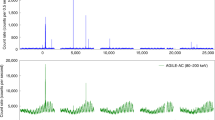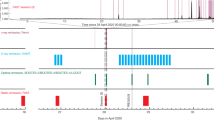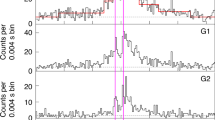Abstract
Fast radio bursts (FRBs) are short pulses observed in the radio band from cosmological distances1. One class of models invokes soft gamma-ray repeaters (SGRs), or magnetars, as the sources of FRBs2. Some radio pulses have been observed from some magnetars3, but no FRB-like events have been detected in association with any magnetar burst, including one giant flare4. Recently, a pair of FRB-like bursts (termed FRB 200428) separated by 29 milliseconds were detected from the general direction of the Galactic magnetar SGR J1935+2154 (refs. 5,6). Here, we report the detection of a non-thermal X-ray burst in the 1–250 keV energy band with the Insight-HXMT satellite7, which we identify as having been emitted from SGR J1935+2154. The burst showed two hard peaks with a separation of 34 milliseconds, broadly consistent with that of the two bursts in FRB 200428. The delay time between the double radio peak and the X-ray peaks is about 8.62 s, fully consistent with the dispersion delay of FRB 200428. We thus identify the non-thermal X-ray burst to be associated with FRB 200428, whose high-energy counterpart is the two hard X-ray peaks. Our results suggest that the non-thermal X-ray burst and FRB 200428 share the same physical origin in an explosive event from SGR J1935+2154.
This is a preview of subscription content, access via your institution
Access options
Access Nature and 54 other Nature Portfolio journals
Get Nature+, our best-value online-access subscription
$29.99 / 30 days
cancel any time
Subscribe to this journal
Receive 12 digital issues and online access to articles
$119.00 per year
only $9.92 per issue
Buy this article
- Purchase on Springer Link
- Instant access to full article PDF
Prices may be subject to local taxes which are calculated during checkout



Similar content being viewed by others
Data availability
The data that support the plots within this paper and other findings of this study are available from the Insight-HXMT website (http://www.hxmt.cn/ or http://www.hxmt.org/).
Code availability
The Insight-HXMT data reduction was performed using software available from the Insight-HXMT website (http://www.hxmt.cn/ or http://www.hxmt.org/). The model fitting of spectra was completed with XSPEC, which is available from the HEASARC website (https://heasarc.gsfc.nasa.gov/).
References
Lorimer, D. R., Bailes, M., McLaughlin, M. A., Narkevic, D. J. & Crawford, F. A bright millisecond radio burst of extragalactic origin. Science 318, 777 (2007).
Petroff, E., Hessels, J. W. T. & Lorimer, D. R. Fast radio bursts. Ann. Rev. Astron. Astrophys. 27, 4 (2019).
Camilo, F. et al. Transient pulsed radio emission from a magnetar. Nature 442, 892–895 (2006).
Tendulkar, S. P., Kaspi, V. M. & Patel, C. Radio nondetection of the SGR 1806-20 giant flare and implications for fast radio bursts. Astrophys. J. 827, 59 (2016).
The CHIME/FRB Collaboration. A bright millisecond-duration radio burst from a Galactic magnetar. Nature 587, 54–58 (2020).
Bochenek, C. D. et al. A fast radio burst associated with a Galactic magnetar. Nature 587, 59–62 (2020).
Zhang, S.-N. et al. Overview to the hard X-ray modulation telescope (Insight-HXMT) satellite. Sci. China Phys. Mech. Astron. 63, 249502 (2020).
Israel, G. L. et al. The discovery, monitoring and environment of SGR J1935+2154. Mon. Not. R. Astron. Soc. 457, 3448–3456 (2016).
Younes, G. et al. X-ray and radio observations of the magnetar SGR J1935+2154 during its 2014, 2015, and 2016 outbursts. Astrophys. J. 847, 85 (2017).
Lin, L. et al. Burst properties of the most recurring transient magnetar SGR J1935+2154. Astrophys. J. 893, 156 (2020).
Lin, L. et al. Fermi/GBM view of the 2019 and 2020 burst active episodes of SGR J1935+2154. Astrophys. J. Lett. 902, L43 (2020).
Kozlova, A. V. et al. The first observation of an intermediate flare from SGR 1935+2154. Mon. Not. R. Astron. Soc. 460, 2008–2014 (2016).
Palmer, D. M. A forest of bursts from SGR 1935+2154. GRB Coord. Netw. 27665 (2020).
Younes, G. et al. The NICER view of the 2020 burst storm and persistent emission of SGR 1935+2154. Astrophys. J. Lett. 904, L21 (2020).
Mereghetti, S. et al. INTEGRAL discovery of a burst with associated radio emission from the magnetar SGR 1935+2154. Astrophys. J. Lett. 898, L29 (2020).
Ridnaia, A. et al. A peculiar hard X-ray counterpart of a Galactic fast radio burst. Nat. Astron. https://doi.org/10.1038/s41550-020-01265-0 (2021).
Kothes, R., Sun, X., Gaensler, B. & Reich, W. A radio continuum and polarization study of SNR G57.2+0.8 associated with magnetar SGR 1935+2154. Astrophys. J. 852, 54 (2018).
Katz, J. I. Coherent emission in fast radio bursts. Phys. Rev. D. 89, 103009 (2014).
Kumar, P., Lu, W. & Bhattacharya, M. Fast radio burst source properties and curvature radiation model. Mon. Not. R. Astron. Soc. 468, 2726–2739 (2017).
Yang, Y.-P. & Zhang, B. Bunching coherent curvature radiation in three-dimensional magnetic field geometry: application to pulsars and fast radio bursts. Astrophys. J. 868, 31 (2018).
Lyubarsky, Y. A model for fast extragalactic radio bursts. Mon. Not. R. Astron. Soc. 442, L9–L13 (2014).
Plotnikov, I. & Sironi, L. The synchrotron maser emission from relativistic shocks in fast radio bursts: 1D PIC simulations of cold pair plasmas. Mon. Not. R. Astron. Soc. 485, 3816–3833 (2019).
Thompson, C. & Duncan, R. C. The soft gamma repeaters as very strongly magnetized neutron stars. I. Radiative mechanism for outbursts. Mon. Not. R. Astron. Soc. 275, 255–300 (1995).
Israel, G. L. et al. A Swift gaze into the 2006 March 29 burst forest of SGR 1900+14. Astrophys. J. 685, 1114–1128 (2008).
Lin, L. et al. Broadband spectral investigations of SGR J1550-5418 bursts. Astrophys. J. 756, 54 (2012).
Lin, L. et al. No pulsed radio emission during a bursting phase of a Galactic magnetar. Nature 587, 63–65 (2020).
Guidorzi, C. et al. A search for prompt γ-ray counterparts to fast radio bursts in the Insight-HXMT data. Astron. Astrophys. 637, A69 (2020).
Marcote, B. et al. A repeating fast radio burst source localized to a nearby spiral galaxy. Nature 577, 190–194 (2020).
Zhang, S. et al. The enhanced X-ray Timing and Polarimetry mission—eXTP. Sci. China Phys. Mech. Astron. 62, 29502 (2019).
Zhang, S. et al. The Insight-HXMT mission and its recent progresses. Proc. SPIE 10699, 106991U (2018).
Li, X. et al. In-flight calibration of the insight-hard x-ray modulation telescope. J. High Energy Astrophys. 27, 64–76 (2020).
Liu, C. et al. The High Energy X-ray telescope (HE) onboard the Insight-HXMT astronomy satellite. Sci. China Phys. Mech. Astron. 63, 249503 (2020).
Cao, X. et al. The Medium Energy X-ray telescope (ME) onboard the Insight-HXMT astronomy satellite. Sci. China Phys. Mech. Astron. 63, 249504 (2020).
Chen, Y. et al. The Low Energy X-ray telescope (LE) onboard the Insight-HXMT astronomy satellite. Sci. China Phys. Mech. Astron. 63, 249505 (2020).
Xiao, S. et al. Deadtime calculation method of the High Energy X-ray telescope (HE) onboard the Insight-HXMT satellite. J. High Energy Astrophys. 26, 58–64 (2020).
Nang, Y. et al. In-orbit calibration to the point-spread function of Insight-HXMT. J. High Energy Astrophys. 25, 39–47 (2020).
Sai, N. et al. Methodology and performance of the two-year Galactic plane scanning survey of Insight-HXMT. J. High Energy Astrophys. 26, 1–10 (2020).
Guan, J. et al. A modified direct demodulation method applied to Insight-HXMT Galactic plane scanning survey. J. High Energy Astrophys. 26, 11–20 (2020).
Acknowledgements
This work made use of the data from the Insight-HXMT mission, a project funded by the China National Space Administration (CNSA) and the Chinese Academy of Sciences (CAS). The Insight-HXMT team gratefully acknowledges support from the National Program on Key Research and Development Project (grant number 2016YFA0400800) from the Minister of Science and Technology of China (MOST) and the Strategic Priority Research Program of the Chinese Academy of Sciences (grant number XDB23040400). We acknowledge support from the National Natural Science Foundation of China under grants U1838105, U1838111, U1838113, U1838202, 11473027, 11733009, U1838201, 1173309, U1838115, U1938109, Y829113, 11673023, U1838104 and 11703002.
Author information
Authors and Affiliations
Contributions
T.P.L. was the initial proposer and Principal Investigator of Insight-HXMT. S.N.Z. has been the current Principal Investigator of Insight-HXMT since 2016, and organized the observations, data analysis and presentation of the results, writing and editing of the paper. L.L. proposed the target-of-opportunity observation, wrote much of the paper and participated in discussions. S.L.X. participated in organizing the observations, data analysis, discussion and paper writing. F.J.L. is a leader in building Insight-HXMT and participated in organizing the data analysis, discussions and paper writing. C.K.L. is the main contributor to the data analysis and participated in paper writing. B.Z. is responsible for theoretical interpretation, and participated in organizing the observations, discussions and paper writing. M.Y.G., Y.L.T., X.B.L., Y.N., S.X., Y.C., L.M.S., Y.T., X.F.Z., C.Z.L., S.M.J., J.Y.L. and B.L. participated in the data analysis and discussion. All other authors contributed to developing, building and operating the Insight-HXMT payloads and science data centre.
Corresponding authors
Ethics declarations
Competing interests
The authors declare no competing interests.
Additional information
Peer review information Nature Astronomy thanks the anonymous reviewers for their contribution to the peer review of this work.
Publisher’s note Springer Nature remains neutral with regard to jurisdictional claims in published maps and institutional affiliations.
Supplementary information
Supplementary Information
Supplementary Figs. 1–6 and Tables 1–6.
Rights and permissions
About this article
Cite this article
Li, C.K., Lin, L., Xiong, S.L. et al. HXMT identification of a non-thermal X-ray burst from SGR J1935+2154 and with FRB 200428. Nat Astron 5, 378–384 (2021). https://doi.org/10.1038/s41550-021-01302-6
Received:
Accepted:
Published:
Issue Date:
DOI: https://doi.org/10.1038/s41550-021-01302-6
This article is cited by
-
Science with a Small Two-Band UV-Photometry Mission I: Mission Description and Follow-up Observations of Stellar Transients
Space Science Reviews (2024)
-
An assessment of the association between a fast radio burst and binary neutron star merger
Nature Astronomy (2023)
-
In-orbit performance of LE onboard Insight-HXMT in the first 5 years
Radiation Detection Technology and Methods (2023)
-
Cosmology with fast radio bursts in the era of SKA
Science China Physics, Mechanics & Astronomy (2023)
-
In-orbit performance of ME onboard Insight-HXMT in the first 5 years
Radiation Detection Technology and Methods (2023)



